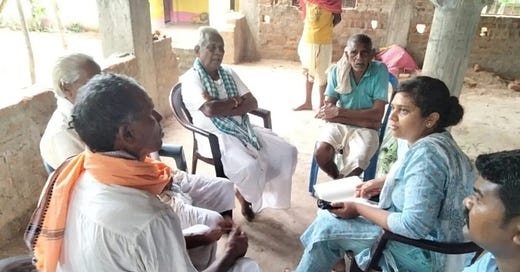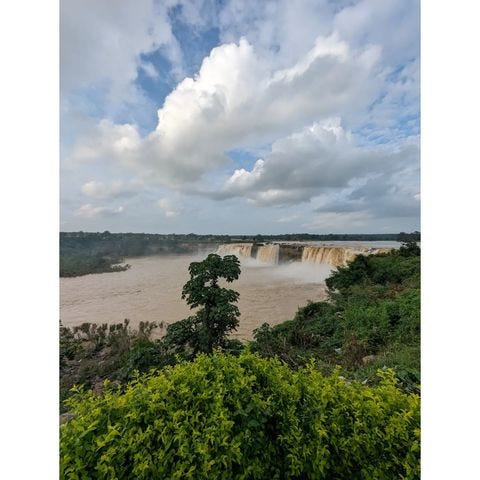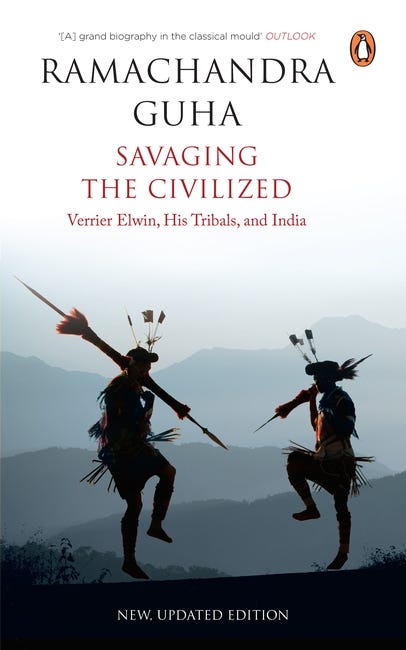Notes from a reporting trip, and on the Jain 'festival' seeking forgiveness
TK #5: Views from Chhattisgarh, excerpts from Ram Guha's biography of Verrier Elwin, a few reads, and thoughts on the Jains
I am late in sending the newsletter out, again. But a lot has happened in the last three weeks. I had three deadlines, and one reporting trip to Chhattisgarh. In the midst of all that, I wrote two half-newsletters, none good enough to be sent out.
After three busy weekends, this past weekend was slightly more relaxed. So here I am. Today’s TK has a splash of religion and faith, and anthropology. There are snapshots of my recent reporting trip interspersed with excerpts from Ramchandra Guha’s Savaging The Civilized, a biography of Verrier Elwin; a few good features I read in the last fortnight; and ending with a brief note Jain ethnographies about the Jain festival of Paryushan.
Last week…
I was in southern Chhattisgarh for a story, which I am co-writing and reporting with Aradhna Wal. I’ll save the details of this exciting story for a later date, perhaps closer to publication. Mid-monsoon Chhattisgarh is verdant and gloomy with a thousand shades of green; streams, lakes, ponds and rivers swollen with muddy rain water; and clouds shape-shifting and teasing you with rain. This is my first reporting trip since I started this newsletter nearly two-and-half months ago. I imagined I would write a dispatch from Chhattisgarh; how naïve I was. Because the chaos and thrill of field reporting most often consumes me, with no mind space for anything but the pursuit of the story and its sources.
Nevertheless, here we are. Just before leaving, I had started reading Ram Guha’s Savaging The Civilized: Verrier Elwin, His Tribals and India. The book is entertaining as its eponymous character lived a rich and exciting life across central India. I learnt about Elwin some ten years ago, and was fascinated by what little I read of his work and views. Guha’s book colourfully covers the extravagant life of this Oxford-educated priest-turned-Gandhian-turned-social worker-turned anthropologist of India’s tribes. Elwin lived in interesting times. He came to India in 1927, and died here in 1964. Through this period he not only saw but also participated in the Indian freedom movement; he witnessed World War 2; watched as India gained independence from the British; watched the nascent years of its democracy in action. He lived amongst and wrote about Gonds, Baigas, Agarias, Bhils, and several more. He wrote around 40 books. Some of his works were truly novel; it was the first time someone had documented or tried to understand the adivasis in detail. Guha writes:
Most of all Verrier Elwin must be distinguished from other primitivists in that he actually lived with the communities whose culture he so vigorously celebrated. The narrator of primitivist reveries has the choice, which he generally exercises, ‘to return, at the end of his sojourn, to the highly civilised countries he came from.’ From Vespucci to Chateaubriand down to the anthropologists of the twentieth century, the European traveller in search of the exotic invariably goes back to where he came from. In an unpublished fragment of autobiography, Elwin wrote of what marked him out from others who extolled the primitive life: ‘Not many of those who wrote so eloquently of the return to nature,’ he remarked, ‘were prepared, however, to take the journey themselves, at least not without a return ticket.’
As I was reading the book, I passed through some of the places Elwin lived in or travelled to as well. This wasn’t by design, just coincidence. One such place was the Chitrakote Falls, where he lived with his first wife, a Gond woman, Kosi. Chitrakote, and the area around it, has changed considerably since the Elwins lived there.
The chiefdom, Verrier told his mother, was ‘unbelievably peaceful;’ its people ‘gentle, friendly, with no desire for property or power.’ He contrasted Bastar’s tribals to warring Europeans. The tribals were a ‘great lesson to the world at this time. So long as men cling to the desire of empire and wealth such catastrophes as the present one are certain to occur.’
But that is not the Bastar I grew up reading about in the news. It is in the news for Maoist attacks, poverty and poor development indicators. The Bastar I was in is beautiful, but people here are not surprised when they see men in military uniform on the highway. Elwin’s views of Hinduism and their influence over tribal groups changed over time–from seeing them with the same lens as Christian missionaries, out there to convert and ‘civilise’ to a multi-faceted faith that meant many things to many people. Guha writes:
“Since Elwin came to Mandla he had developed a strong dislike of Hinduism, for it was Hindus who—as moneylenders, landlords and officials—were the chief tormentors of his Baiga and Gonds. But in Bastar he discovered that Hinduism as a theological system was not that far removed from aboriginal thought. For the social life of the chiefdom revolved around the Dassera festival, when thousands of tribals from the hills descended on Jagdalpur to pay tribute to their king, whom they worshipped as the messenger on earth of Durga. The anthropologist concluded that the faith of the Bastar tribal ‘was really closely related to Shaivite Hinduism. It is true that the feeling-tones are different but so are those of Protestantism and Catholicism. Yet we call both those totally different faiths Christianity.’”
I am yet to make my way through this tome, but here’s another excerpt before we move on–I know that Elwin had an influence over India’s policies around tribals. But I have always wondered what makes anthropologists different from journalists or people who write about their own communities. What is it about anthropologists’ dispassionate accounts of others that often accords their words a superiority and establishes their narratives as something we should pay attention to? For Elwin, who wasn’t a trained anthropologist, this struggle was real.
He studied theology at Oxford, was ordained as a priest and came to India as a missionary to do social work. Before embarking on his studies of the tribes, he gave up priesthood.
Here, Guha explores Indian sociologist MN Srinivas’ description of an academic life. Srinivas said an anthropologist had three births:
“...an anthropologist is ‘onceborn’ when he goes to the field for the first time, thrust abruptly into an unfamiliar world. He is ‘twice-born’ when, after living for some time among the community, he is able to see things from their perspective: a second birth akin to a Buddhist surge of consciousness for which years of study or mere linguistic facility do not prepare you. An anthropologist is truly ‘thrice-born’ only when he moves back to the university, his fieldwork completed. Here he reflects on his material and situates it in a theoretical context, while being alerted to competing subjectivities by colleagues returning from their field-sites and communities. The anthropologist’s special allegiance to his own tribe can never be entirely abandoned, but his third incarnation allows him the hope of achieving at least a partial objectivity, which is the mark of a scholar as distinct from a propagandist.”
The charge that he was not anthropologist or scientist enough was one with which Elwin was to become tiresomely familiar. To the professional who prides himself on his detachment Elwin would remain forever in the stage of twice- bornness, always and invariably seeing things from the perspective of the community he studied and identified with. A third birth required a move to the academic founts of the LSE, and this was not a move he was willing to make. It was not so much that no foundation was willing to fund this venture, but rather that, unlike the university anthropologist, he had come to the field with no intention of going back to the Senior Common Room.”
In the last couple of days…
…I read a few interesting features. Here are two from India that I really liked:
Ankita Apurva’s brilliant feature in Behenbox— What Beauty Parlours In Jharkhand Villages Tell Us About Gender, Caste And Hope–is beautifully written and edited. She effectively combines two styles of writing–reporting with personal essay–to let us into a world we don’t have access to. Beauty parlours in villages are windows to women’s worlds and ambitions, and Apurva seems to have a VIP pass to it. She writes:
“I have been visiting beauty parlours in rural, semi-rural and semi-urban pockets of Jharkhand with the women of my family since I was a child. I have always found these parlours to be small pockets of rebellion and assertion. Here, young girls who had been instructed to keep their heads down and their tongues quiet, find the freedom to giggle as they get their hair trimmed minimally so their families would not notice. Perhaps the trim would not be visible if they were to wear their hair in two braids?”
Aradhna Wal’s insightful piece in The Signal titled The struggle to be counted as disabled, is worth a read. India has unreliable statistics and data on disabled people. Moreover, the next round of the National Family Health Survey will not be asking disability related questions. Wal explores the impact it has on persons with disabilities, and how the systematic exclusion in enumeration results in exclusion from schemes and policies, she reports.
“The state works through enumeration. To be counted, especially as a specific identity, is a political victory for a community and for an individual. “It is a way to stake political identity, to stake a claim on the state and on its welfare measures,” Kurian underlines. For a disabled person, or anyone from a marginalised group, your claim to anything the state offers is only if you get counted.”
Tomorrow…
…one sect of the Jain community will celebrate the end of an eight-day festival called Paryushan. I belong to that sect, the Swetambars. The way Jains celebrate this is antithetical to the meaning of ‘festive’. It is marked by austerities in every way–fasting, lesser consumption and hours of rituals which include meditations and prayers. There are no dinners post sunset, and few meals made of minimal ingredients. Most Jains do not eat greens or vegetables these days, opting for a diet of dals, grains and other dried food.
Here’s a good Wikipedia-like page to understand Paryushan: Jainpedia
On the fifth day, the Jains complete the reading of Kalpasutra, their holy book which has stories of the 24 Tirthankaras. It also marks the immaculate conception of Mahavira, the 24th Tirthankara.
On the eighth day is Samvatsari, which marks the end of Paryushan. Over the past several decades, it has coincided with Vinayak Chaturthi. While the Hindus in north India are busy with grand celebrations, music and processions, the Jains do the opposite. It should not come as a surprise that I have never witnessed a Vinayak Chaturthi celebration. Practising Jains hold a fast where they either don’t eat anything at all (for 36 hours), or have just one short meal for the day. That evening they retreat into their homes, temples and community halls for quiet penance in Pratikraman (a mass of sorts), which lasts for 3-4 hours in the evening.
Through the Pratikraman, and afterwards, Jains ask for forgiveness–from the Gods, the universe, each other and themselves. This is marked by the greeting “Michchami Dukkadam”, which in Prakrit means “to be forgiven” or “may all evil that has been done be forgiven”.
Consider it the opposite of the American tradition of Thanksgiving. Here, the Jains ask forgiveness from the insects they’ve hurt during their time on Earth to the people they’ve hurt with their words or actions. There’s a long list of possible harm Jains have done which is recited in Pratikaman. But the speed at which the nuns, who lead us into the Pratikraman, recite those scriptures, I’ve never understood what that list is after almost two decades of partaking in this ritual.
After the Pratikraman is over, they visit each relatives and friends houses to greet Michchami Dukhadam.
I briefly flirted with religious studies in the first half of my working life, almost seven years ago. During this time, I wrote about Tamil Jains [you can read the work here], and also went into rabbit holes where I read ethnographies of the Jains.
There are several scholars in the US, UK and Europe—and even Japan—who have worked on the Jains and their faith. There are journal articles and books across various disciplines—from anthropology to archeology. The topics they cover are Jain history; Jain contribution to science, mathematics and society (such as influence on various movements in India); Jain rituals, practices and lifestyle; gender and Jainism; and a lot more. I won’t drop names here, but if anyone reading on any of these or if they are interested in talking about it more, you know where to find me.
It has been surprising how little Jains themselves are engaged with this material. Throughout my childhood, people around me focussed on rituals and learning scriptures from rote. Most of Jain literature is in Prakrit. But I have yet to come across a single Jain person who has actually studied the language. The most devout Jain around me won’t be able to tell you the meaning of what Mahavir actually said, because they probably don’t understand it.
In the UK, I learnt of study groups at SOAS, and other places, which learnt Prakrit and then read Jain scriptures and books. I was amused and astounded. I wanted to join them, but felt I had limited capacity to do so. This is just one of many discrepancies which I have seen over the years. I feel the community–and I–would benefit a lot from self-reflection and critical thinking, by engaging with each other, their past (I assure you, it’s not always glorious) and the very essence of what Jainism is. But that is for another time.
For now: Michchami Dukhadam to everyone who’s reading this.
Until the next time!
Best,
Mahima Jain





